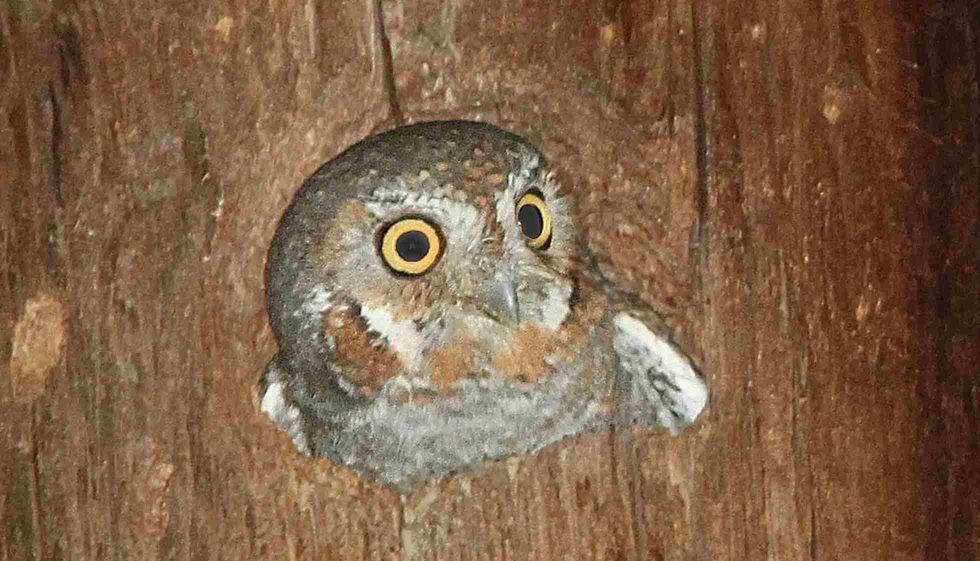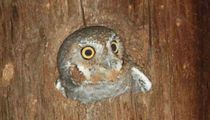Distributed over the terrains of central Mexico, the Baja California peninsula, and the Southwestern United States, is the species of one of the smallest categories of owls, that is, the elf owl.
Scientifically known as micrathene whitneyi, these avians with patterned plumage and coloring are particularly famous for their weeny dimensions, which, in fact, is the foundation of the clan designation Elf. Like most members of the owl family, elf owls are also the wanderers of the night.
These yellow-eyed owls with brimming white eyebrows are biologically categorized under the family of true owls, that is, Strigidae.
Read on to discover some amazing facts about the elf owl species. After reading these interesting facts about elf owl adaptations, do check our these great grey owl facts and tawny owl.
Elf Owl Interesting Facts
What type of animal is an elf owl?
The elf owl or micrathene whitneyi, is a species of owl recognized globally for its tiny stature. These owls belong to the family of true or typical owls, which is one amongst the two biologically defined families of owls; the other being the Tytonidae family.
What class of animal does an elf owl belong to?
Elf owls are the classified members of class Aves; that is, the biological classification of organisms characterized by the presence of forelimbs modified into wings, and the body is covered with feathers. This nesting bird species is comfortable living in the desert.
How many elf owls are there in the world?
A number of recognized organizations such as What Bird Resource and World of Zoos and Aquariums (WAZA), have provided a rough estimation of the global population of micrathene whitneyi, which stands at between 190,000-200,000 owls respectively.
Where does an elf owl live?
Elf owls are found in a large range of habitats. The habitation includes subtropical thorn woodlands, partially urbanized areas, upland deserts, riparian canyon forests, and montane evergreen woodlands.
What is an elf owl's habitat?
Elf owl habitat spans across Southwestern United States, the Baja California peninsula, and central Mexico. During cold winters, elf owls are known to displace to the terrains of central and southern Mexico.
Whereas during the spring season, these birds of prey travel back north. California, Texas, New Mexico, and Arizona constitute the resident pads for these tiny avians during summer migration.
Who do elf owls live with?
Micrathene whitneyi are usually found to be living in isolation. However, these birds of prey switch to forming small population groups, particularly during mobbing predators and during migration. Pairs are formed during the breeding season. Elf owls are recognized to be quite territorial.
How long does an elf owl live?
The lifespan of micrathene whitneyi is about 3-5 years. However, it may live up to 10 years of age in captivity. Also when they are not in contact with any disease or exposed to predators, and competition in and outside of the species, their longevity increases.
How do they reproduce?
Micrathene whitneyi are known to exhibit vocal courtships, during which these birds of prey call out in high-pitched songs, following which these nesting birds form monogamous pairs. The male then guides the female to a safe nesting site.
In general, female elf owls are known to raise broods only once a year. The average clutch size ranges between 1-5 elf owl eggs.
Having laid the eggs in the nests, females take over any incubation routines and necessities as required in the nest. This incubation period in the elf owl nests lasts for about 24 days, following which the egg hatches.
When the chick reaches the age of 28-33 days, it fledges. The breeding season in these tiny avians is observed to generally span from April to July.
What is their conservation status?
The population of elf owls as of now is declining largely due to the loss of habitat for these birds, caused by deforestation, destruction of desert areas, and human inversions. However, as of now, they are still categorized as least concern by the IUCN Red List.
While in contrast, elf owls are categorized as endangered on the conservation scale in California and Texas due to their declining numbers.
Elf Owl Fun Facts
What do elf owls look like?
With a patterned plumage of grayish-brown, these tiny birds are quite adorable. Their facial disk is adorned with beady eyes in pale yellow shades. White eyebrows conspicuously mark the eyes of the elf owl.
The under part of Micrathene whitneyi (that is, the abdomen region) ranges from white tones to cinnamon-brown streaks. The tail is morphologically short, whereas the feet are tan to dull yellow in shades. The bill is either greenish-yellow or gray in tone.
How cute are they?
Owing to their tiny size, bright yellow eyes, and patterned plumage, whenever spotted, they make an adorable and engaging sight to behold.
How do they communicate?
Elf owls use their screeching vocals to communicate with the other members of their species. Their tones are high-pitched and contain varying songs.
How big is an elf owl?
Usually compared with the dimensions of the sparrow, the family of elf owls, are regarded as one of the smallest members of the owl realm. The average length of elf owls ranges between 4.9-5.7 in (12.4-14.4 cm).
How fast can an elf owl fly?
There are no records of the flying speeds of elf owls. They can be seen flying at a moderate pace and increase their speed when they see their prey. They are known to hunt with an excellent silent flight in darkness.
How much does an elf owl weigh?
With an average weight of 1.23-1.4 oz (0.034-0.039 kg), Micrathene whitneyi are known to be the lightest owls in the world.
What are their male and female names of the species?
There are no specific names allotted to the members of species Micrathene whitneyi based on their sex. Males are referred to as male elf owls while females are referred to as female elf owls.
What would you call a baby elf owl?
The offspring of elf owls are known as owlets or elf owl chicks.
What do they eat?
Elf owls are carnivorous organisms and their diet mainly includes small mammals, reptiles, and insects of their habitats. To tend to their food requirements, these birds tend to feed on moths, rodents such as rats, crickets, centipedes, scorpions, beetles, and crickets.
Are they dangerous?
Elf owls prefer living in isolation and avoid human company. However, when provoked or when guarding their territory, they may display aggressive behavior.
Elf owl predators include other owls, coyotes, snakes, bobcats, and ringtails.
Would they make a good pet?
Elf owls may prove to be wonderful pets provided the owner is experienced and can provide all the needs for these tiny avians. You must also undertake elf owl size comparison as well as understand the requirements of the elf owl diet before you decide to adopt an elf owl pet.
Did you know...
The members of micrathene whitneyi species are known to be notoriously high on dramatics. These tiny avians play dead, acquiring a still or frozen stance when contacted with dire circumstances such as enraptured by predators.
The elf owl's Adaptations
In order to settle well in their surroundings, the members of micrathene whitneyi, like other owls, possess excellent visual as well as acoustic receptors. Silent flight, excellent vision, and sound detection in the dark facilitate hunting. These visual and acoustic anatomical arrangements also help these nocturnal avians.
The elf owl's nest
The elf owl's nest in an abandoned place that is free of cavities and can be located in oak trees. The distance between the nest and the ground from the tree is 15-35 ft (4.5-10.6 m).
How did the elf owl get its name
The elf owl is scientifically known as Micrathene whitneyi, which is coined by combining the name of their genus and species. The generic name of these avians, Micrathene, stands for 'the little owl'.
Here at Kidadl, we have carefully created lots of interesting family-friendly animal facts for everyone to discover! For more relatable content, check out these barn owl facts and short-eared owl facts.
You can even occupy yourself at home by drawing one on our Elf Owl coloring pages.










